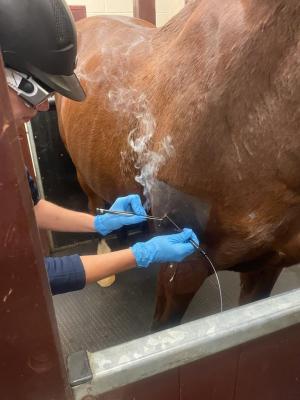Equine Therapy for Children: Psychological and Behavioral Support Clarified
Equine Therapy for Children: Psychological and Behavioral Support Clarified
Blog Article
Exactly How Laser Treatment in Horse Treatment Is Reinventing Veterinary Look After Steeds
Laser therapy has emerged as a transformative method in equine veterinary care, providing a non-invasive service that expedites recovery and enhances general wellness. The transportability and versatility of laser therapy devices even more underscore their expanding necessity amongst vets.

Understanding Laser Therapy
Comprehending laser therapy is crucial for appreciating its duty in equine therapy. Laser therapy, likewise known as photobiomodulation, involves the application of particular wavelengths of light to tissues, which can cause various biological results. This therapeutic modality takes advantage of the power of light power to pass through the skin and underlying tissues, stimulating mobile processes and improving cells fixing.
The technology behind laser therapy is based in the principle of photochemistry, where photons are soaked up by chromophores within cells, resulting in enhanced ATP production and modulation of reactive oxygen varieties. This, subsequently, advertises mobile spreading, minimizes inflammation, and speeds up recovery. Veterinary experts use different types of lasers, consisting of low-level lasers (LLLT) and high-power Class IV lasers, depending upon the details therapeutic goals and the nature of the equine problem being treated.
Different laser wavelengths and power setups are thoroughly selected to target numerous tissue midsts and attain wanted medical end results. Security methods are extremely important, as incorrect use can result in thermal damages or suboptimal therapeutic impacts. Hence, a comprehensive understanding of laser therapy's systems and applications is critical for its efficient implementation in equine veterinary technique.
Advantages for Horse Health And Wellness
The myriad benefits of laser treatment for equine health incorporate improved recovery, pain decrease, and improved flexibility. This innovative therapy modality leverages particular wavelengths of light to penetrate cells, boosting cellular function and promoting fast tissue fixing. The non-invasive nature of laser treatment makes sure minimal anxiety and pain for the horse, assisting in a smoother recovery process.

Better wheelchair is one more important benefit, especially for efficiency and working steeds. By decreasing inflammation and discomfort, and improving cells fixing, laser therapy aids in recovering joint feature and muscle mass flexibility. The cumulative effect of these advantages is not just a quicker return to typical task however likewise an overall enhancement in the horse's quality of life. Hence, laser treatment stands as a transformative tool in modern-day equine vet treatment.
Common Problems Dealt With
Laser treatment has actually emerged as a versatile treatment alternative for a selection of typical equine conditions. In addition, laser treatment is reliable for problems like osteoarthritis, where it assists minimize joint inflammation and promote tissue repair work.
Wound monitoring is another area where laser therapy has revealed considerable promise. Chronic injuries or slow-healing ulcers can be especially difficult in horses, yet laser treatment improves mobile regeneration and enhances blood circulation, therefore accelerating the recovery procedure. Additionally, laser therapies have been effectively utilized in taking care of unguis problems such as laminitis and abscesses, alleviating pain and promoting faster healing.
Horse athletes typically struggle with performance-related issues like muscular tissue soreness and stress and anxiety fractures. Laser therapy help in reducing muscular tissue fatigue and expedites the recuperation of micro-injuries, hence ensuring that steeds return to peak performance quicker. By attending to these diverse conditions, laser treatment is changing the landscape of vet care, supplying a non-invasive, reliable option to typical treatments.
Innovation Behind Laser Treatment

Laser tools used in vet medication often use low-level laser treatment (LLLT) or chilly laser therapy. Unlike high-powered surgical lasers, these tools operate at lower power why not try here degrees, optimizing restorative advantages while lessening thermal damage. The power from the laser light promotes adenosine triphosphate (ATP) production, enhances cellular metabolism, and accelerates tissue fixing procedures.
Modern laser treatment tools for equine therapy is created with adjustable settings to satisfy the specific needs of various cells and problems. Equine Therapy. Criteria such as wavelength, power density, and treatment duration can be carefully tuned, providing customized restorative remedies. Furthermore, improvements in laser technology have actually led to the advancement of mobile, handheld devices, making it less complicated for vets to provide therapy in a range of setups, from centers to stables. This technical advancement is a cornerstone in the reinventing of equine veterinary care.
Success Stories and Study
Showcasing the substantial advantages of laser therapy, various success tales and study illuminate its transformative influence on equine health and wellness. One such situation involves a pedigreed racehorse suffering from anonymous persistent tendonitis. Conventional therapies produced minimal renovation, however after incorporating laser therapy into the routine, the equine exhibited considerable reductions in swelling and discomfort within weeks, ultimately going back to affordable auto racing.
Another compelling instance includes a dressage steed diagnosed with extreme pain in the back, restricting its performance. A vet group used low-level laser therapy (LLLT) to target the swollen areas, leading to marked Discover More Here improvement in versatility and a noteworthy reduction in discomfort. Over a number of sessions, the steed reclaimed its peak form, showcasing the efficacy of laser therapy in dealing with musculoskeletal problems.
In addition, a research performed at a leading equine clinic analyzed 50 equines with different soft tissue injuries treated with laser treatment. The outcomes stood out: 85% of the steeds showed increased recovery times and boosted flexibility. These instances emphasize the flexibility and efficiency of laser therapy in equine medicine, offering a non-invasive, scientifically-backed method to enhancing recovery and performance in equines.
Conclusion
Laser treatment is changing equine veterinary treatment by giving a non-invasive therapy that accelerates healing, decreases inflammation, and reduces pain. With its performance in dealing with a variety of problems, from musculoskeletal injuries to chronic ailments like osteo arthritis, this innovation considerably enhances equine wellness and wheelchair. The portability and flexibility of laser treatment even more underscore its transformative influence on veterinary practices, strengthening its role as an important tool in modern equine medical care.
Report this page